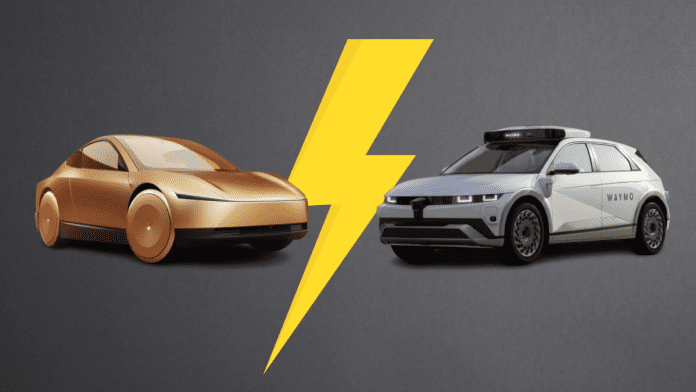🕒 Last updated on July 18, 2025
A major change is quietly taking place on the roads of America. Not with drivers but without them. Self-driving taxis, also called robotaxis, are finally here. And two giants are leading the charge: Waymo and Tesla.
A New Kind of Taxi War Is Brewing
Waymo, a well-known name in self-driving tech, has spent years testing and improving its robotaxi service. People who’ve used it say it feels better than a regular Uber ride. The car drives smoothly, makes safe choices, and comes right to your doorstep. But Waymo now faces a new challenge: getting more cars on the road to meet demand. Their current fleet uses Jaguar I-Pace electric vehicles. These are fast, sleek, and silent. But each one costs around $150,000 once the self-driving equipment is added. That’s very expensive.
To fix this, Waymo has teamed up with Zeekr, a Chinese car company. Together, they are creating a new type of robotaxi, designed from the ground up for self-driving use. It’s called the Zeekr RT, and it’s built in Arizona, not China. The base car called the Zeekr MIX costs about $40,000. Waymo then adds cameras, sensors, radars, and computers to make it fully autonomous. These upgrades include:
- 13 high-quality cameras
- 4 lidars to map surroundings in 3D
- 6 radars to detect motion
- External speakers to talk to passengers
- Self-cleaning sensors to stay clear in all weather
With all the parts combined, the new Zeekr robotaxi costs around $75,000, which is half the price of the Jaguar version. That means Waymo could double its profit or lower ride costs to reach more people.
Tesla’s Low-Cost Strategy Is Raising Eyebrows
But Waymo isn’t alone in this race.
Tesla, another big name in electric vehicles, is moving fast into the robotaxi market. Their testing has already started in Austin, Texas. Tesla is using a new car, rumored to be called the Cybercab, which may cost just $20,000 to $25,000 per vehicle.
Unlike Waymo, Tesla’s robotaxis don’t use expensive lidar or radar. Instead, they rely fully on cameras and computer vision. This makes each car much cheaper to build. Tesla’s strong control over its parts and software means it can reduce costs even more than other companies.
While Tesla’s technology is less expensive, its current performance doesn’t match Waymo’s. Waymo’s vehicles can drive up to 14,000 miles before needing human help (a disengagement). Tesla’s test cars, on the other hand, average around 500 miles per disengagement. That’s a big gap.
Still, Tesla’s cost advantage is huge. If they can improve performance, they could dominate the robotaxi market by offering rides at much lower prices.
What It Means for Cities and Riders
Waymo is already operating in cities like San Francisco, Phoenix, and Los Angeles. It is also preparing to launch in New York City, one of the busiest and most chaotic urban areas in the world. If their cars can safely drive there, it will prove how ready their system really is.
Elon Musk’s Chatbot Grok Spreads Discredited ‘White Genocide’ Lie — Sparks AI Oversight Demands
Robotaxis could change the way people move in cities. With no driver salaries and no need to tip, prices may drop. A ride across town could cost much less than a regular Uber or Lyft. That would make robotaxis appealing to more people.
Cheaper robotaxis could also reduce the need for personal cars. Why buy a car, pay for parking, and deal with traffic when you can call a ride with your phone in seconds? This shift might affect jobs too. Fewer drivers would be needed, and some taxi and delivery jobs might disappear.
Waymo’s Zeekr RT, priced at $75,000, is already cutting costs. Tesla’s Cybercab could go even lower, possibly down to one-third the price of Waymo’s car. That’s where the real competition lies: who can offer reliable rides for the lowest cost.
Both companies are racing forward. One is focused on high performance and safety. The other is aiming for low prices and wide reach. The result could shape the future of transportation in every major city.
The streets may look the same for now. But behind the scenes, the quiet robotaxi race is heating up, and it could change everything.

